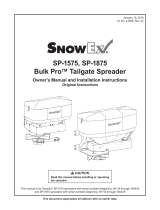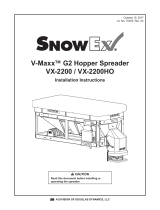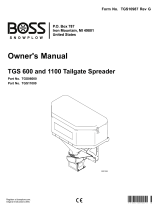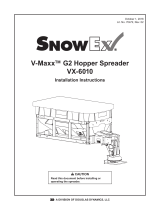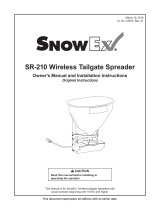Page is loading ...

This document supersedes all editions with an earlier date.
July 1, 2016
Lit. No. 43771, Rev. 01
PRO‑FLO™ 525, PRO‑FLO™ 900
Low‑Prole Tailgate Spreader
#91800, 91850
Owner's Manual
Original Instructions
This manual is for WESTERN® PRO‑FLO 525 and PRO‑FLO 900 Low‑Prole Tailgate Spreaders
with serial numbers beginning with 150601 through 160729.
CAUTION
Read this manual before installing or operating
the spreader.
Western Products, PO Box 245038, Milwaukee, WI 53224‑9538 • www.westernplows.com


Lit. No. 43771/43773, Rev. 01 3 July 1, 2016
TABLE OF CONTENTS
INTRODUCTION ......................................................... 5
Owner's Information Form .................................... 5
SAFETY INFORMATION ............................................ 6
Safety Denitions ..................................................6
Warning/Caution Labels .......................................6
Serial Number Label .............................................7
Safety Precautions ................................................ 8
Personal Safety..................................................... 8
Fire and Explosion ................................................9
Cell Phones ........................................................... 9
Ventilation .............................................................9
Fuses .................................................................... 9
Battery Safety ....................................................... 9
Noise ..................................................................... 9
Vibration ................................................................9
LOADING .................................................................. 10
Certication ......................................................... 10
Approximate Material Weights ............................ 10
MOUNTING THE SPREADER ................................. 11
Model 900 .......................................................... 11
Model 525 ........................................................... 11
License Plate Installation .................................... 12
OPERATING THE SPREADER ................................ 13
Driving and Spreading on Snow and Ice ............ 13
Starting and Stopping Spreader ......................... 14
Controlling Material Application .......................... 15
BLAST/Maximum Application ....................... 15
Cab Control Modes ............................................. 15
Ready Mode ................................................. 15
ON Mode ...................................................... 15
Error Mode ................................................... 15
Cab Control Codes—Table ................................. 16
Setup Procedures ............................................... 18
Calibrate Empty Hopper Setting ................... 18
Adjust LED Brightness Level ........................ 18
Auto-Reverse Feature ......................................... 19
Vibrator Function ................................................. 19
Controlling Flow of Material ................................ 19
Spreading Tips .................................................... 19
MAINTENANCE ........................................................20
Lubrication .......................................................... 20
After Each Use .................................................... 20
At the End of Each Season or after
Extended Storage ............................................ 20
Storage ...............................................................20
Fuse Replacement .............................................. 20
HARNESS WIRING DIAGRAM ................................ 21
TROUBLESHOOTING GUIDE .................................22


Lit. No. 43771, Rev. 01 5 July 1, 2016
INTRODUCTION
This manual has been prepared to acquaint you with
the safety information, operation and maintenance of
your new tailgate spreader. Please read this manual
carefully and follow all recommendations. This will
help ensure protable and trouble‑free operation of
your spreader. Keep this manual accessible. It is a
handy reference in case minor service is required.
When service is necessary, bring your spreader to
your distributor. They know your spreader best and are
interested in your complete satisfaction.
NOTE: This spreader is designed to spread snow
and ice control materials only. Do not use it for
purposes other than those specied in this manual.
Register your spreader online at www.westernplows.com
OWNER'S INFORMATION
Owner's Name: ______________________________________________________________________
Date Purchased: _____________________________________________________________________
Distributor Name: __________________________________________ Phone: _________________
Distributor Address: ___________________________________________________________________
Vehicle Model: _____________________________________________ Year: __________________
Spreader Model: _________________________ Serial #: __________________________________
Spreader Weight: _____________________lb/kg

Lit. No. 43771/43773, Rev. 01 6 July 1, 2016
SAFETY INFORMATION
SAFETY DEFINITIONS
NOTE: Indicates a situation or action that can lead
to damage to your spreader and vehicle or other
property. Other useful information can also be
described.
WARNING/CAUTION LABELS
Please become familiar with the Warning and Caution
labels on the spreader.
NOTE: If labels are missing or cannot be read, see
your sales outlet.
CAUTION
Indicates a potentially hazardous situation
that, if not avoided, may result in minor or
moderate injury. It may also be used to alert
against unsafe practices.
WARNING
Indicates a potentially hazardous situation
that, if not avoided, could result in death or
serious personal injury.
ROTATING AUGER CAN CAUSE
SERIOUS INJURY OR DEATH
• Keep arms, hands, and loose clothing
away from auger.
• Shut o control and unplug spreader
before servicing.D6335
Spreaders With Swing Mount
Option Only

Lit. No. 43771/43773, Rev. 01 7 July 1, 2016
SAFETY INFORMATION
SERIAL NUMBER LABEL
Model No. 00000
Serial No. 000000000000000000
Code Denition
YY 2‑Digit Year
MM 2‑Digit Month
DD 2‑Digit Day
LL 2‑Digit Location Code
XXXX 4‑Digit Sequential Number
ZZZZZZ Assembly Part Number
Model No. 00000
Serial No. YYMMDDLLXXXXZZZZZZ

Lit. No. 43771/43773, Rev. 01 8 July 1, 2016
SAFETY INFORMATION
SAFETY PRECAUTIONS
Improper installation and operation could cause
personal injury and/or equipment and property
damage. Read and understand labels and the
Owner's Manual before installing, operating or making
adjustments.
WARNING
• Driver to keep bystanders minimum of
25 feet away from operating spreader.
• Before working with the spreader, secure all
loose‑tting clothing and unrestrained hair.
• Before operating the spreader, verify all
safety guards are in place.
• Before servicing the spreader, wait for
auger and spinner to stop.
• Do not climb into or ride on spreader.
WARNING
Overloading could result in an
accident or damage. Do not exceed
GVWR or GAWR ratings as found on
the driver‑side door cornerpost of
the vehicle. See Loading Section to determine
maximum volumes of spreading material.
WARNING
Do not install the control for this product in
the deployment path of an air bag. Refer to
vehicle manufacturer's manual for air bag
deployment area(s).
CAUTION
During the hopper spreader installation
we recommend the addition of an OSHA
compliant Backup Alarm. This alarm is
required for OSHA governed employers.
CAUTION
• Do not operate a spreader in need of
maintenance.
• Before operating the spreader, reassemble
any parts or hardware removed for cleaning
or adjusting.
• Before operating the spreader, remove
materials such as cleaning rags, brushes,
and hand tools from the spreader.
• While operating the spreader, use auxiliary
warning lights, except when prohibited by law.
CAUTION
Disconnect electric and/or hydraulic power
and tag out if required before servicing or
performing maintenance.
CAUTION
DO NOT leave unused material in
hopper. Material can freeze or solidify,
causing unit to not work properly.
Empty and clean after each use.
NOTE: Lubricate grease ttings after each use.
Use a good quality multipurpose grease.
PERSONAL SAFETY
• Remove ignition key and put the vehicle in park or
in gear to prevent others from starting the vehicle
during installation or service.
• Wear only snug‑tting clothing while working on
your vehicle or spreader.
• Do not wear jewelry or a necktie, and secure long
hair.
• Wear safety goggles to protect your eyes from
battery acid, gasoline, dirt and dust.
• Avoid touching hot surfaces such as the engine,
radiator, hoses and exhaust pipes.
• Always have a re extinguisher rated BC handy,
for ammable liquids and electrical res.
CAUTION
If rear directional, CHMSL light or brake
stoplights are obstructed by the spreader,
the lights shall be relocated, or auxiliary
directional or brake stoplights shall be
installed.

Lit. No. 43771/43773, Rev. 01 9 July 1, 2016
SAFETY INFORMATION
FIRE AND EXPLOSION
Be careful when using gasoline. Do not use gasoline
to clean parts. Store only in approved containers away
from sources of heat or ame.
CELL PHONES
A driver's rst responsibility is the safe operation of
the vehicle. The most important thing you can do
to prevent a crash is to avoid distractions and pay
attention to the road. Wait until it is safe to operate
Mobile Communication Equipment such as cell
phones, text messaging devices, pagers or two‑way
radios.
VENTILATION
CAUTION
Batteries normally produce explosive gases
which can cause personal injury. Therefore,
do not allow ames, sparks or lit tobacco
to come near the battery. When charging or
working near a battery, always cover your
face and protect your eyes, and also provide
ventilation.
• Batteries contain sulfuric acid which burns
skin, eyes and clothing.
• Disconnect the battery before removing or
replacing any electrical components.
WARNING
Vehicle exhaust contains lethal fumes.
Breathing these fumes, even in low
concentrations, can cause death. Never
operate a vehicle in an enclosed area without
venting exhaust to the outside.
WARNING
Gasoline is highly ammable and gasoline
vapor is explosive. Never smoke while
working on vehicle. Keep all open ames
away from gasoline tank and lines. Wipe up
any spilled gasoline immediately.
FUSES
The spreader electrical system contains several blade‑
style automotive fuses. If a problem should occur
and fuse replacement is necessary, the replacement
fuse must be of the same type and amperage rating
as the original. Installing a fuse with a higher rating
can damage the system and could start a re. Fuse
Replacement, including fuse ratings and locations, is
located in the Maintenance section of this Owner's
Manual.
BATTERY SAFETY
NOISE
Airborne noise emission during use is below 70 dB(A)
for the spreader operator.
VIBRATION
Operating spreader vibration does not exceed 2.5 m/s2
to the hand-arm or 0.5 m/s2 to the whole body.

Lit. No. 43771/43773, Rev. 01 10 July 1, 2016
LOADING
This Manual covers vehicles which have been
recommended for carrying the spreader. Please see
your local dealer for proper vehicle applications.
CERTIFICATION
SPREADER SPECIFICATIONS
Model Weight
Max.
Capacity
Model 525 Tailgate Spreader with 160 lb 5.25 ft3
Standard Mount
Model 900 Tailgate Spreader 180 lb 9.0 ft3
2" Receiver Hitch Mount w/
Adapter 84 lb –
Pivot Mount 89 lb –
3‑Point Mount 38 lb –
WARNING
Overloading could result in an accident or
damage. Do not exceed GVWR or GAWR
as found on the driver‑side cornerpost of
vehicle.
WARNING
New untitled vehicle installation of a spreader
requires National Highway Trafc Safety
Administration altered vehicle certication
labeling. Installer to verify that struck load of
snow or ice control material does not exceed
GVWR or GAWR rating label and complies
with FMVSS.
CAUTION
Read and adhere to manufacturer's
ice‑control material package
labeling including Material Safety
Data Sheet requirements.
APPROXIMATE MATERIAL WEIGHTS
Material Density
(lb/ft3)
Rock Salt (Dry) 80–90
Sand/Salt Mix (Dry) 95–120
A 1:1 ratio is recommended for salt/sand mix
to prevent material from freezing.
Weight of spreader and mount must be added to
struck material weight to determine total spreader
weight.
NOTE: If spreader and ice control material loading
is in doubt, weigh vehicle for compliance with
vehicle ratings.
WARNING
Do not overload vehicle. Use chart below
to calculate weight of material. Weights of
material are an average for dry materials.
CAUTION
Never use wet materials or materials with
foreign debris with any of these spreaders.
These units are designed to handle dry, clean,
free owing material.

Lit. No. 43771/43773, Rev. 01 11 July 1, 2016
MOUNTING THE SPREADER
CAUTION
During removal or mounting, securely grip
spreader to avoid dropping.
The spreader shall be installed according to
instructions supplied. Your local outlet is trained to
provide this service and service your spreader with
factory original parts.
MODEL 900
Mounts are sold separately for the model 900
spreader. Refer to the instructions packed with the
selected mount.
MODEL 525
The model 525 spreader ships from the factory with
the hitch set up in the 3‑point mount position.
To switch the spreader to the truck mount position,
remove the hitch, rotate it 180° as shown below, and
reinstall it.
3-POINT MOUNT
POSITION
TRUCK MOUNT
POSITION
Hitch Pin
Hitch PinLift Arm Pins

Lit. No. 43771/43773, Rev. 01 12 July 1, 2016
LICENSE PLATE INSTALLATION
(IF REQUIRED)
Install the license plate to the mounting holes in the
frame using two 1/4" x 1/2" machine screws and two
1/4" locknuts.
Model 525
License Plate Mounting Holes
Model 900
(2 Options)
Always use the longer (1‑1/2") cap screw and washer
to attach the corner of the hitch that ts behind the tab
of the material chute.
1/2" x 1-1/2" Cap Screw
and 1/2" Washer
1/2" x 1"
Cap Screws
MOUNTING THE SPREADER

Lit. No. 43771/43773, Rev. 01 13 July 1, 2016
DRIVING AND SPREADING ON SNOW
AND ICE
Follow your vehicle owner's manual instructions for
driving in snow and ice conditions. Remember, when
you drive on snow or ice, your wheels will not get good
traction. You cannot accelerate as quickly, turning
is more difcult, and you will need longer braking
distance. Wet and hard packed snow or ice offer the
worst tire traction. It is very easy to lose control. You
will have difculty accelerating. If you do get moving,
you may have poor steering and difcult braking,
which can cause you to slide out of control.
CAUTION
Drinking and then driving or spreading is
very dangerous. Your reexes, perceptions,
attentiveness and judgement can be affected
by even a small amount of alcohol. You can
have a serious or even fatal collision if you
drive after drinking. Please do not drink then
drive or spread ice‑control materials.
Here are some tips for driving in these conditions:
• Drive defensively.
• Do not drink, then drive or spread ice‑control
materials.
• Spread or drive only when you have good visibility
for operating a vehicle.
• If you cannot see well due to snow or icy
conditions, you will need to slow down and keep
more space between you and other vehicles.
• Slow down, especially on higher‑speed roads.
Your headlamps can light up only so much road
ahead.
• If you are tired, pull off in a safe place and rest.
• The spreader's size and location reduce driver
visibility to the rear of the vehicle. We recommend
an OSHA compliant backup alarm for all governed
employers.
• Keep your windshield and all glass on your vehicle
clean to see around you.
• Dress properly for the weather. Wear layers of
clothing; as you get warm, you can take off layers.
OPERATING THE SPREADER

Lit. No. 43771/43773, Rev. 01 14 July 1, 2016
OPERATING THE SPREADER – CAB CONTROL
WARNING
Never operate equipment when under the
inuence of alcohol, drugs, or medications that
might alter your judgment and/or reaction time.
WARNING
Never allow children to operate or climb on
equipment.
WARNING
Never exceed 45 mph (72 km/h) when loaded
spreader is attached to vehicle. Braking
distances may be increased and handling
characteristics may be impaired at speeds
above 45 mph (72 km/h).
WARNING
Before starting the spreader, the driver shall
verify that all bystanders are a minimum of
25 feet away from operating spreader.
STARTING AND STOPPING SPREADER
To start the spreader, press the ON/OFF button. The
control backlights are illuminated when the vehicle
ignition is ON. When the spreader is ON, the ON/OFF
button and inner arc around each control knob will
also illuminate.
To stop the spreader, press the ON/OFF button
again.
The ON/OFF button also operates as an emergency
stop when required.
NOTE: The truck ignition must be ON to start
the spreader.
NOTE: If truck ignition is turned OFF while
spreader is running, the motors will stop.
Material
Width
Material
Flow
VIBRATELIGHT AUX
MIN MAX
ON/OFF
MI
NM
AX
BLAST
Material Width
Control Knob
(Spinner Speed)
Indicator Lights
(8 per Knob)
Material Flow
Control Knob
(Feed Rate)
Status/Error Code
Display (Red)
Accessory
Control Buttons
BLAST Button
(Maximum Application)
ON/OFF Button
& Emergency Stop

Lit. No. 43771/43773, Rev. 01 15 July 1, 2016
OPERATING THE SPREADER – CAB CONTROL
CONTROLLING MATERIAL APPLICATION
The material application settings can be adjusted
while spreader is ON or OFF. Settings are shown by
the indicator lights around the control knobs. When
the spreader is OFF, a single LED will light to show the
current setting. When the spreader is ON, the number
of blue LEDs illuminated will increase/decrease as the
knobs are turned clockwise/counterclockwise.
The auger drive will not deliver material until the ON
button is pressed.
The Material Width (left) knob controls spinner speed.
Turning the knob clockwise will increase the width of
the application area.
The Material Flow (right) knob controls the auger
drive. Turning the knob clockwise will increase the
feed rate of material to the spinner.
Turning the control knobs counterclockwise will
decrease the width of the application area and the
feed rate of material.
BLAST/Maximum Application
1. Press and hold the BLAST button when maximum
ow rate and application area are needed
temporarily. The BLAST button will illuminate
while depressed.
2. Release the button when maximum application
settings are no longer needed.
NOTE: Spinner speed and material feed rate revert
to the previous settings once the BLAST button
is released.
CAB CONTROL MODES
If "1.8" appears on the display while the cab control is
powering up, the control is running software v1.8. See
the Lit. No. 70502, Rev. 01, supplement to this manual.
Ready Mode
Vehicle ignition is set to ACC or ON; cab control is OFF.
Control has power.
The Material Width and Material Flow control knobs
can be set to start‑up conditions, but the spinner and
drives will not operate until the control is turned ON.
Accessory lights and vibrator are operational. The
BLAST function is not operational.
ON Mode
Vehicle ignition is set to ACC or ON; cab control is
ON. Spinner and hopper motors will start. All cab
control functions are operational. Accessory lights and
vibrator are operational.
During normal spreader operation no control codes are
displayed. Information or setup codes will appear when
relevant. These codes will not stop spreader operation.
Error Mode
When an error condition occurs, spreader operation
will shut down. A two‑digit error code will ash on the
display and a beep will sound. If there are multiple error
codes, the codes will ash in a repeating sequence.
Refer to the Error Codes portion of the
following Cab Control Codes table. Also see the
Troubleshooting Guide section of this manual.
Once the error condition has been resolved, press the
ON/OFF button to clear the error code(s). Press the
ON/OFF button again to resume spreader operation.
The error code will reappear if the error condition
has not been rectied. If the error condition persists,
contact your authorized dealer.
Multiple resets within a short time frame will cause
the hopper module to time out if components are
overheating. The control will display an EF error code.
Accessory work lights and AUX can be used when an
error code is in effect, and will remain in their current
state. The vibrator will not function.

Lit. No. 43771/43773, Rev. 01 16 July 1, 2016
OPERATING THE SPREADER – CAB CONTROL
CAB CONTROL CODES
Setup Codes
Code Denition Procedure
Cb Calibrate the Empty Hopper setting. With control in ON mode, press and hold the left control knob until the
Cb code displays. Calibration cycle is automatic.*
Cc Clear calibration data for Empty Hopper
setting; clear EH code.
Press the right control knob to clear all calibration data during the
calibration cycle.
LS Set LED brightness level. With control in Ready mode, press and hold left control knob to get
LS code. Release pressure and turn left control knob to desired
brightness setting. Wait for conrming SL code to display.*
SL Conrms that LED brightness level has
been reset.
* For full instructions, see the "Setup Procedures" section.
Information Codes
Code Denition Response
Ar Auto‑reverse sequence is active. The spreader will automatically detect and attempt to clear a jam. See
the "Operating the Spreader" section of this manual.
dU Not applicable to tailgate spreaders.
Possibly indicates a harness or
module issue.
Contact authorized dealer.
EH Empty hopper (beep will sound). Check hopper for material.
Recalibrate Empty Hopper setting as described above for Cb code.
Lb Low battery. Hopper module is sensing
< 10V. (Lb becomes an error code
when module senses < 6V.)
Refer to the Lb row under "Error Codes" (next page).
Error Codes – Spreader Operation Stopped
Code Denition Possible Cause Suggested Solution
bb Bad button Button is stuck.
Button was pressed while
vehicle ignition was entering
ACC or START mode.
Possible harness issue.
Inspect control. Free up button.
Do not press any spreader cab control buttons
while the vehicle ignition is being engaged.
Check connections and integrity of vehicle
harness.
bH Bad hopper Possible module or control
mismatch.
Replace control or module. Use only genuine
service parts. Contact authorized dealer.
CE No communication with
spreader module
Loose connection.
Module lost power.
Conrm that spreader and control harnesses are
connected to the vehicle harness. Check fuses,
power to spreader module, all connections and
power studs. Check that B port is plugged into
the module.
CF Control malfunction Control is overheating.
May be a combination of faults.
Inspect connections at spreader module, hopper
drive motor and spinner drive motor.

Lit. No. 43771/43773, Rev. 01 17 July 1, 2016
OPERATING THE SPREADER – CAB CONTROL
Error Codes – Spreader Operation Stopped – continued
Code Denition Possible Cause Suggested Solution
CP Not applicable to tailgate
spreaders. See suggested
solution.
Not applicable to tailgate
spreaders.
Reset the control by pressing the ON/OFF
button. If CP code continues to display, contact
authorized dealer.
Ct Control is hot. Cab temperature is too high.
Control overheated.
Turn off spreader and allow control to cool off.
EF Excessive drive faults Too many HO and/or SO
error codes; hopper module
overheating.
Control times out for 60 seconds.
Ensure that auger and/or spinner are not jammed.
HO Hopper overload –
software trip
Drive system has high current.
Material is jammed.
Auger is damaged.
Inspect auger; clear material jam.
HO . Hopper overload –
hardware trip
HP Hopper power issue.
No motor present.
Hopper drive motor is not
connected.
Possible motor defect.
Check connections to the auger drive motor
(P—FEED and FEED—N posts on the module
and studs on the motor).
Replace the motor.
Lb Low battery. Hopper
module is sensing < 6V.
Bad connection or low battery.
Snowplow or other vehicle
power use may be driving
down voltage.
Voltage is measured at the hopper module, so
Lb code may indicate cable voltage loss. Check
battery, alternator and connections.
nC No connection Spreader not connected to
vehicle harness.
Connect vehicle and spreader harness.
Check vehicle harness fuse.
Inspect spreader and vehicle harnesses.
Check module.
OH Overheating Spreader module is too hot.
Spreader module malfunction.
Accessories wiring/function
problem.
Drive motor overload.
Allow a cool‑off period—60 seconds or longer.
Check for loose harness connections.
Check accessory connections. Check integrity of
accessory wiring and harness.
Clear jammed material.
Contact authorized dealer.
OH . Overheating module –
microprocessor
rS Reset of spreader module Power loss to module detected
on startup.
Reset the control by pressing the ON/OFF button.
Check vehicle harness and battery connection.
SO Spinner drive overload –
software trip
Material jammed in
chute/spinner area.
Spinner shaft is damaged.
Inspect spinner and spinner drive components for
alignment and condition. Check for damage to
bearings, shafts and sprockets.
Adjust and replace parts as required.
SO . Spinner drive overload –
hardware trip
SP Spinner power issue.
No motor present.
Spinner drive motor is not
connected.
Possible motor defect.
Check connections to the motor (SPIN and GND
posts on the module).
Replace the motor.

Lit. No. 43771/43773, Rev. 01 18 July 1, 2016
SETUP PROCEDURES
Calibrate the Empty Hopper Setting
(Cb and EH Codes)
Calibrating the empty hopper setting enables the cab
control to alert the operator when the hopper is empty.
Recalibrate the empty hopper setting at the start of
each ice-control season.
1. Ensure that the hopper is empty before beginning
the calibration.
2. Turn the vehicle ignition to ACC or ON. Press
the ON/OFF button on the cab control to turn the
control ON.
3. Press and hold the Material Width (left) knob
for approximately 10 seconds until the Cb code
displays.
4. The calibration cycle will begin. The blue LEDs
around the Material Flow (right) knob will illuminate
in succession until all 8 are lit.
5. When the automatic calibration cycle is complete,
the control will automatically revert to the previous
material application settings.
If the control is turned OFF or loses power during
the calibration cycle, the calibration data will be lost.
Make sure the control is ON and restart the calibration
process at Step 3.
Once the empty hopper setting has been calibrated,
the EH code will ash on the display and a beep will
sound whenever the hopper is empty. The EH code is
informational only and will not stop spreader operation.
Clearing Empty Hopper Calibration Data (Cc Code)
The empty hopper calibration may be cleared, if
desired. The control will no longer display the EH
status code when the hopper is empty.
Start the calibration cycle as described above. At
Step 4, press the Material Flow (right) knob during the
calibration cycle to clear all calibration data. The Cc
(Clear Calibration) code will display and the control will
exit Cc mode automatically.
Adjust LED Brightness Level
(LS and SL Codes)
The brightness setting of the cab control lights can be
adjusted from 1 to 16. The factory default setting is 8.
1. Turn the vehicle ignition to ACC or ON. If
necessary, press the cab control ON/OFF button
to turn the control OFF.
2. Press and hold the Material Width (left) knob for
approximately 3 seconds until the LS code is
displayed.
3. Release the knob and turn it clockwise or
counterclockwise to increase/decrease the
brightness level. The light level number will show
in the status display.
4. After selecting the desired brightness level, wait
a few seconds for the SL conrmation code to
display.
NOTE: A brightness level setting of 12 or higher is
recommended for daylight conditions.
OPERATING THE SPREADER – CAB CONTROL

Lit. No. 43771/43773, Rev. 01 19 July 1, 2016
CONTROLLING FLOW OF MATERIAL
The factory‑installed material bafe in the spreader
stops ne materials from free owing. When dense
or damp material is being spread, or when more ow
is desired, remove the material bafe. However, it is
recommended that the bafe remain in place when
spreading bulk salt.
The inverted vee in the model 900 spreader should
not be removed except when servicing the spreader.
The Material Control Tube optional accessory
prevents leaking issues when handling ne pellet and
ake materials.
SPREADING TIPS
• Spread ice melters with the storm to prevent
unmanageable levels of ice.
• Never exceed 10 mph (16 km/h) when spreading.
• For a wider pass, increase spinner speed.
• For a heavier pass, drive slower or increase
auger speed.
• Never operate spreader near pedestrians.
• Calculate spread pattern when near vegetation.
NOTE: The spinner motor is not designed for
continuous duty. Allow the motor to cool between
long cycle times.
OPERATING THE SPREADER
AUTO‑REVERSE (Ar) FEATURE
If "1.8" appears on the cab control display when the
control is powering up, see the Auto-Reverse Feature
instructions in Lit. No. 70502, Rev. 01.
The spreader is programmed to automatically sense
and clear material jams.
The Ar sequence will begin automatically, and consist
of a series of reverse-then-forward movements of the
auger.
The Ar sequence will make up to ve attempts to
clear the jam. If the jam is cleared, the auger will
automatically return to normal operation at the
previous control settings.
If the jam remains after the auto-reverse cycle is
exhausted, the control will indicate the HO error code
(Hopper Overload), and shutdown the spreader.
If the HO error code is displayed, then the operator
must extract the material that is causing the problem.
Follow all warning directions when clearing jams.
VIBRATOR FUNCTION
A heavy‑duty vibrator is standard equipment on the
model 525 and 900 spreaders. Turn the vibrator ON
as needed to keep dense material owing and prevent
bridging of material in the hopper.
CAUTION
Disconnect electric power and tag out if
required before servicing or performing
maintenance.

Lit. No. 43771/43773, Rev. 01 20 July 1, 2016
MAINTENANCE
LUBRICATION
To keep your spreader running smoothly, observe the
following recommendations:
• Lubricate bearings after every 20 hours of use.
• Apply a small amount of light oil to latches as
needed.
• For model 900 spreader installations using the
pivot mount, keep the pivot assembly well greased
to prevent corrosion.
AFTER EACH USE
• Wash out the hopper and rinse off all external
surfaces.
• Apply dielectric grease on all electrical
connections to prevent corrosion.
AT THE END OF EACH SEASON
OR AFTER EXTENDED STORAGE
• Wash out the hopper and rinse off all external
surfaces.
• Apply dielectric grease on all electrical
connections to prevent corrosion.
• Lubricate all grease ttings with good quality
multipurpose grease.
• Oil or paint all bare metal surfaces.
• If motor cover is removed for any reason, use
silicone sealant to ensure weather proong of
enclosure.
STORAGE
Unplug the cab control from the control harness at the
end of the season, or when the spreader is removed
from the vehicle. Store the spreader and cab control in
a clean, dry location, away from direct sunlight.
FUSE REPLACEMENT
See the Harness Wiring Diagram on the following
page for fuse ratings and locations.
If a problem should occur and fuse replacement is
necessary, the replacement fuse must be of the same
type and amperage rating as the original. Installing a
fuse with a higher rating can damage the system and
could start a re.
WARNING
Never remove the spreader with material in
the hopper.
CAUTION
• When replacing parts use only original
manufacturer's parts. Failure to do so will
void warranty.
• The control is a solid‑state electronic unit
and is not serviceable. Any attempt to
service will void warranty.
• There are no serviceable parts in the motor/
transmission assembly. Any attempt to
service will void warranty.
• When pressure washing motor enclosure
area, stay at least 36" away from motor
enclosures.
CAUTION
Disconnect electric power at spreader
electrical wiring harness connection and tag
out if required before servicing or performing
maintenance.
CAUTION
DO NOT leave unused material in
hopper. Material can freeze or solidify,
causing unit to not work properly.
Empty and clean after each use.
/


